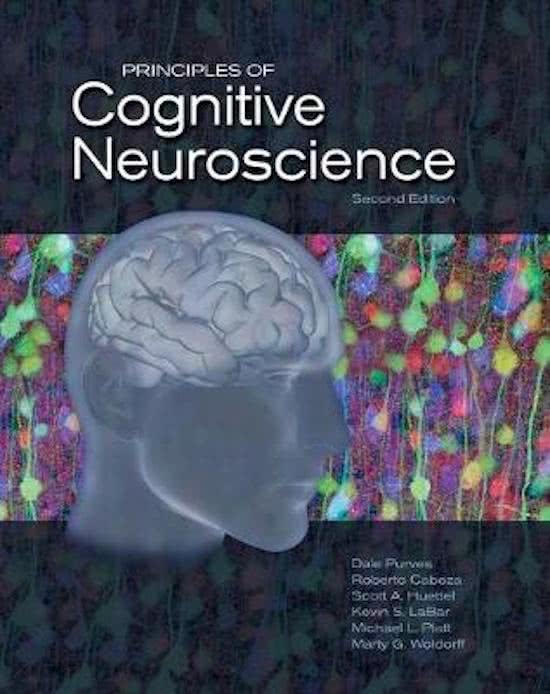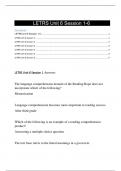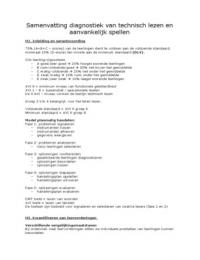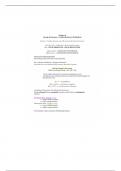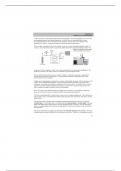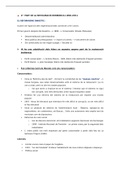The Adaptive Brain
Studying the nervous system (chapter 1)
The genome
- The human genome consists of about 20.000 genes of which some 14.000 are expressed in
the developing or mature nervous system.
- The individual genes are regulated differentially throughout the nervous system, as
measured by the amount of mRNA expressed from region to region and from one cell type
to another.
- Variable messages transcribed from the same gene, called splice variants, add diversity by
allowing a single gene to encode information for a variety of related protein products.
- Mutant genes can either cause degenerative disorders of the adult brain, such as
Huntington’s and Parkinson’s diseases.
Model organisms in Neuroscience
- In the past cats were used to study the brain. After this they used the squid and Aplysia
californica, which yielded critical insights into the basic cell biology of neurons, synaptic
transmission and synaptic plasticity.
- Currently, the model organisms that are used are the nematode worm C. elegans, the fruit
fly D. melanogaster, the zebrafish D. rerio and the mouse.
- One advantage of these model species is that the wealth of genetic and genomic
information for each permit sophisticated manipulation of gene expression and function.
Cellular components of the nervous system
- Camillo Golgi articulated the reticular theory of nerve cell
communication, in which he argued that everything in the nervous
system is a single continuous network.
- His theory was replaced by the neuron doctrine, which is the concept
that the nervous system is made up of discrete individual cells
- Synapses are the apparent transfers of electrical signals at synaptic
junctions between nerve cells.
- Gap junctions allow for cytoplasmic continuity and the direct transfer
of electrical and chemical signals between cells in the nervous
system.
- Components of neurons and glia;
o Mitochondria tend to be concentrated at synapses in
neurons, while protein-synthetic organelles such as the
endoplasmic reticulum are largely excluded from axons and
dendrites.
- Cells of the nervous system can be divided into two broad categories
o Neurons; specialized for electrical signalling over long distances and intercellular
communication by means of synapses.
Most neurons have only one axon that extends for a relatively long distance
from the location of the cell body.
Dendrites are the primary targets for synaptic input from the axon terminals
of other neurons and are distinguished by their high content of ribosomes.
Have elaborative branches, the variation in the size and branching of
dendrites is enormous and of importance in establishing the information-
processing capacity of individual neurons.
, The number of inputs to a single neuron reflects the degree of convergence
while the number of targets innervated by any one neuron represents its
divergence.
The synaptic contacts made by axon endings on dendrites (and less
frequently on neuronal cell bodies) represent a special elaboration of the
secretory apparatus found in many polarized epithelial cells. Typically, the
axon terminal of the presynaptic neuron is immediately adjacent to a
specialized region of postsynaptic receptors on the target cell.
Pre and post synaptic components communicate via the secretion of
neurotransmitters from the presynaptic terminal that bind to receptors in
the postsynaptic cell. The space between the pre- and postsynaptic
elements is called the synaptic cleft.
Short axons are a feature of local circuit neurons, or interneurons,
throughout the nervous system.
The axons of projection neurons extend to distant targets, for example the
axons that run from the spinal cord tot the foot (1 m long).
Axons convey electrical signals over such distances by a self-regenerating
wave of electrical activity called an action potential.
The most abundant synapse in the mature nervous system are the chemical
synapses, while the electrical synapses are abundant in the developing CNS.
The secretory organelles in the presynaptic terminals are synaptic vesicles
and are vesicles filled with neurotransmitters and in some cases neuroactive
molecules.
o Glial cells; support the signaling functions
of nerve cells rather than generating
electrical signals themselves.
Functions:
Maintaining the ionic
milieu of nerve cells
Modulating rate of nerve signal propagation
Modulating synaptic action by controlling the uptake and
metabolism of neurotransmitters at or near the synaptic cleft
Providing a scaffold for some aspects of neuronal development
Aiding recovery from neural injury
Providing an interface between the brain and the immune system
Facilitating the connective flow of interstitial fluid through the brain
during sleep
Three types of differentiated glial cells in the CNS;
Astrocytes, which are restricted to the CNS, have elaborate local
processes. A major function of astrocytes is to maintain an
appropriate chemical environment for neuronal signalling, including
formation of the blood brain barrier.
Oligodendrocytes, which are also restricted to the CNS, lay down a
laminated, lipid rich wrapping called myelin around some, but not
all, axons. Myelin has important effects on the speed of the
transmission of electrical signals.
o The cells that provide myelin are called Schwann cells.
Microglial cells are derived primarily from hematopoietic precursor
cells. They are primarily scavenger cells that remove cellular debris
from sites of injury or normal cell turnover. And secrete signalling
, molecules (cytokines) that can modulate local inflammation and
influence whether other cells survive or die.
Glial stem cells are found throughout the adult brain and retain the capacity
to proliferate and generate additional precursors or differentiated glia, and
in some cases neurons. Can be divided into two categories:
A subset of astrocytes found primarily near the ventricles in a region
called the subventricular zone or adjacent to ventricular zone blood
vessels. Can give rise to neurons, mature astrocytes and
oligodendrocytes.
Oligodendrocyte precursors scattered throughout the white matter
and sometimes referred to as polydendrocytes. More limited in their
potential to develop, they give primarily rise to mature
oligodendrocytes as well as some astrocytes.
Cellular diversity in the nervous system
- Neurons never function in isolation; they are organized into ensembles called neural circuits
that process specific kinds of information.
- The synaptic connections that underlie neural circuits are made in a dense tangle of
dendrites, axon terminals and glial cell processes that together constitute what is called
neuropil (the regions between nerve cell bodies where mist synaptic connectivity occurs).
- The basic constituents of all neural circuits:
o Nerve cells that carry information from the periphery toward the brain or spinal cord
are called afferent neurons.
o Nerve cells that carry information away from the brain or spinal cord are efferent
neurons.
o Interneurons participate only in the local aspects of a circuit, based on the short
distances over which their axons extend
- An example of a neural circuit is the myotatic reflex (knee reflex). The afferent neurons that
control the reflex are sensory neurons whose cell bodies lie in the dorsal root ganglia and
send axons peripherally that terminate in sensory endings in skeletal muscles. The central
axons of these sensory neurons enter the spinal cord, where they terminate on a variety of
central neurons concerned with the regulation of muscle tone/motor neurons that
determine the activity of related muscles. The interneurons receive synaptic contacts from
sensory afferent neurons and make synapses on the efferent motor neurons that project to
the flexor muscles. The excitatory synaptic connections between the sensory afferents and
the extensor efferent motor neurons cause the extensor muscles to contract; at the same
time, interneurons activated by the afferents are inhibitory, and their activation diminishes
electrical activity in flexor efferent motor neurons and causes the flexor muscles to become
less active. The result is a complementary activation and inactivation of the synergistic and
antagonistic muscles that control the position of the leg.
- Ways to study neural circuits;
o Electrophysiological recording; measures the electrical activity of a nerve cell. There
are two approaches, extracellular recording, where an electrode is places near the
nerve cell of interest (used for temporal patterns of action potentials) ; and
intracellular recording, where the electrode is placed inside the cell of interest
(smaller graded changes in electrical potential that trigger action potentials).
o Calcium imaging records the transient changes in intracellular concentration of
calcium ions that are associated with action potential firing.
o Voltage-sensitive fluorescent dyes that are inserted into the neuronal plasma
membrane and report on the transmembrane potential, thereby imaging the
Studying the nervous system (chapter 1)
The genome
- The human genome consists of about 20.000 genes of which some 14.000 are expressed in
the developing or mature nervous system.
- The individual genes are regulated differentially throughout the nervous system, as
measured by the amount of mRNA expressed from region to region and from one cell type
to another.
- Variable messages transcribed from the same gene, called splice variants, add diversity by
allowing a single gene to encode information for a variety of related protein products.
- Mutant genes can either cause degenerative disorders of the adult brain, such as
Huntington’s and Parkinson’s diseases.
Model organisms in Neuroscience
- In the past cats were used to study the brain. After this they used the squid and Aplysia
californica, which yielded critical insights into the basic cell biology of neurons, synaptic
transmission and synaptic plasticity.
- Currently, the model organisms that are used are the nematode worm C. elegans, the fruit
fly D. melanogaster, the zebrafish D. rerio and the mouse.
- One advantage of these model species is that the wealth of genetic and genomic
information for each permit sophisticated manipulation of gene expression and function.
Cellular components of the nervous system
- Camillo Golgi articulated the reticular theory of nerve cell
communication, in which he argued that everything in the nervous
system is a single continuous network.
- His theory was replaced by the neuron doctrine, which is the concept
that the nervous system is made up of discrete individual cells
- Synapses are the apparent transfers of electrical signals at synaptic
junctions between nerve cells.
- Gap junctions allow for cytoplasmic continuity and the direct transfer
of electrical and chemical signals between cells in the nervous
system.
- Components of neurons and glia;
o Mitochondria tend to be concentrated at synapses in
neurons, while protein-synthetic organelles such as the
endoplasmic reticulum are largely excluded from axons and
dendrites.
- Cells of the nervous system can be divided into two broad categories
o Neurons; specialized for electrical signalling over long distances and intercellular
communication by means of synapses.
Most neurons have only one axon that extends for a relatively long distance
from the location of the cell body.
Dendrites are the primary targets for synaptic input from the axon terminals
of other neurons and are distinguished by their high content of ribosomes.
Have elaborative branches, the variation in the size and branching of
dendrites is enormous and of importance in establishing the information-
processing capacity of individual neurons.
, The number of inputs to a single neuron reflects the degree of convergence
while the number of targets innervated by any one neuron represents its
divergence.
The synaptic contacts made by axon endings on dendrites (and less
frequently on neuronal cell bodies) represent a special elaboration of the
secretory apparatus found in many polarized epithelial cells. Typically, the
axon terminal of the presynaptic neuron is immediately adjacent to a
specialized region of postsynaptic receptors on the target cell.
Pre and post synaptic components communicate via the secretion of
neurotransmitters from the presynaptic terminal that bind to receptors in
the postsynaptic cell. The space between the pre- and postsynaptic
elements is called the synaptic cleft.
Short axons are a feature of local circuit neurons, or interneurons,
throughout the nervous system.
The axons of projection neurons extend to distant targets, for example the
axons that run from the spinal cord tot the foot (1 m long).
Axons convey electrical signals over such distances by a self-regenerating
wave of electrical activity called an action potential.
The most abundant synapse in the mature nervous system are the chemical
synapses, while the electrical synapses are abundant in the developing CNS.
The secretory organelles in the presynaptic terminals are synaptic vesicles
and are vesicles filled with neurotransmitters and in some cases neuroactive
molecules.
o Glial cells; support the signaling functions
of nerve cells rather than generating
electrical signals themselves.
Functions:
Maintaining the ionic
milieu of nerve cells
Modulating rate of nerve signal propagation
Modulating synaptic action by controlling the uptake and
metabolism of neurotransmitters at or near the synaptic cleft
Providing a scaffold for some aspects of neuronal development
Aiding recovery from neural injury
Providing an interface between the brain and the immune system
Facilitating the connective flow of interstitial fluid through the brain
during sleep
Three types of differentiated glial cells in the CNS;
Astrocytes, which are restricted to the CNS, have elaborate local
processes. A major function of astrocytes is to maintain an
appropriate chemical environment for neuronal signalling, including
formation of the blood brain barrier.
Oligodendrocytes, which are also restricted to the CNS, lay down a
laminated, lipid rich wrapping called myelin around some, but not
all, axons. Myelin has important effects on the speed of the
transmission of electrical signals.
o The cells that provide myelin are called Schwann cells.
Microglial cells are derived primarily from hematopoietic precursor
cells. They are primarily scavenger cells that remove cellular debris
from sites of injury or normal cell turnover. And secrete signalling
, molecules (cytokines) that can modulate local inflammation and
influence whether other cells survive or die.
Glial stem cells are found throughout the adult brain and retain the capacity
to proliferate and generate additional precursors or differentiated glia, and
in some cases neurons. Can be divided into two categories:
A subset of astrocytes found primarily near the ventricles in a region
called the subventricular zone or adjacent to ventricular zone blood
vessels. Can give rise to neurons, mature astrocytes and
oligodendrocytes.
Oligodendrocyte precursors scattered throughout the white matter
and sometimes referred to as polydendrocytes. More limited in their
potential to develop, they give primarily rise to mature
oligodendrocytes as well as some astrocytes.
Cellular diversity in the nervous system
- Neurons never function in isolation; they are organized into ensembles called neural circuits
that process specific kinds of information.
- The synaptic connections that underlie neural circuits are made in a dense tangle of
dendrites, axon terminals and glial cell processes that together constitute what is called
neuropil (the regions between nerve cell bodies where mist synaptic connectivity occurs).
- The basic constituents of all neural circuits:
o Nerve cells that carry information from the periphery toward the brain or spinal cord
are called afferent neurons.
o Nerve cells that carry information away from the brain or spinal cord are efferent
neurons.
o Interneurons participate only in the local aspects of a circuit, based on the short
distances over which their axons extend
- An example of a neural circuit is the myotatic reflex (knee reflex). The afferent neurons that
control the reflex are sensory neurons whose cell bodies lie in the dorsal root ganglia and
send axons peripherally that terminate in sensory endings in skeletal muscles. The central
axons of these sensory neurons enter the spinal cord, where they terminate on a variety of
central neurons concerned with the regulation of muscle tone/motor neurons that
determine the activity of related muscles. The interneurons receive synaptic contacts from
sensory afferent neurons and make synapses on the efferent motor neurons that project to
the flexor muscles. The excitatory synaptic connections between the sensory afferents and
the extensor efferent motor neurons cause the extensor muscles to contract; at the same
time, interneurons activated by the afferents are inhibitory, and their activation diminishes
electrical activity in flexor efferent motor neurons and causes the flexor muscles to become
less active. The result is a complementary activation and inactivation of the synergistic and
antagonistic muscles that control the position of the leg.
- Ways to study neural circuits;
o Electrophysiological recording; measures the electrical activity of a nerve cell. There
are two approaches, extracellular recording, where an electrode is places near the
nerve cell of interest (used for temporal patterns of action potentials) ; and
intracellular recording, where the electrode is placed inside the cell of interest
(smaller graded changes in electrical potential that trigger action potentials).
o Calcium imaging records the transient changes in intracellular concentration of
calcium ions that are associated with action potential firing.
o Voltage-sensitive fluorescent dyes that are inserted into the neuronal plasma
membrane and report on the transmembrane potential, thereby imaging the

